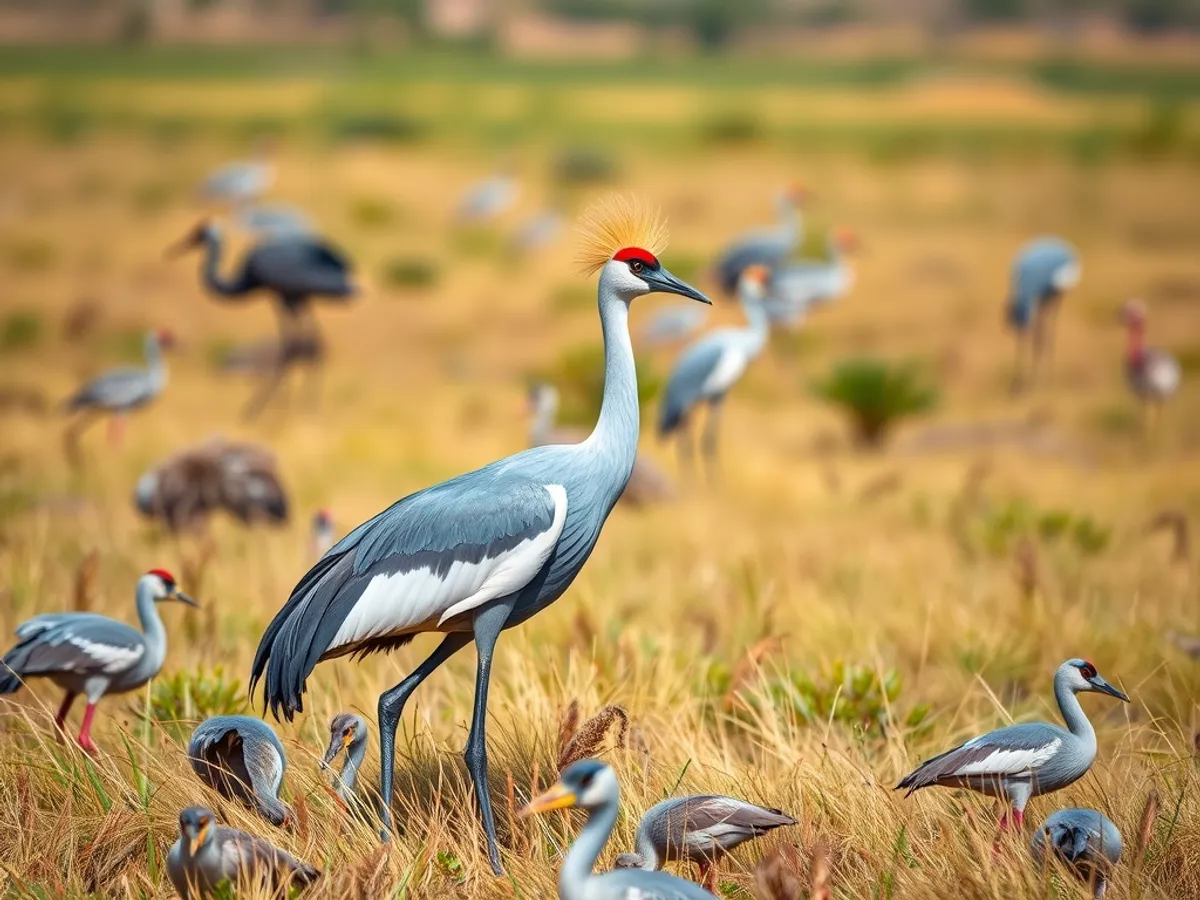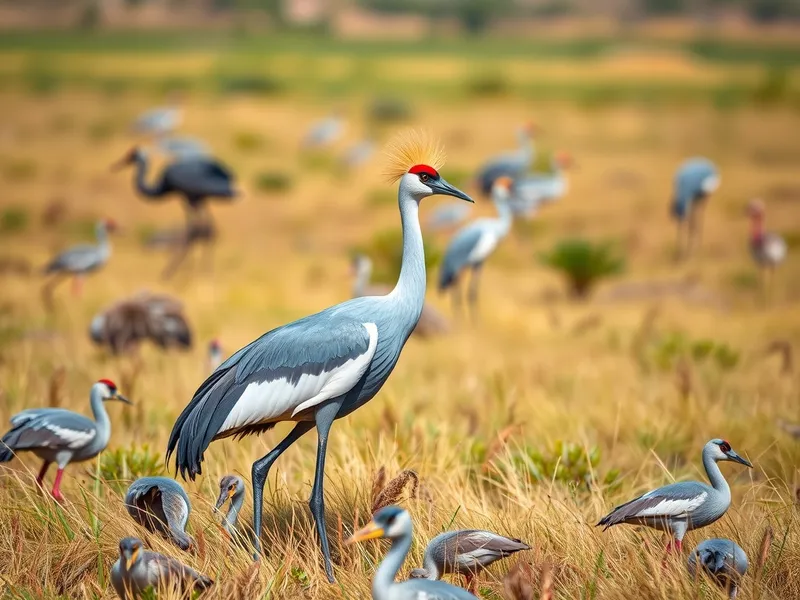
Demoiselle Crane
Anthropoides virgo

Meet the Demoiselle Crane
The Demoiselle Crane is a graceful, medium-sized crane species known for its slender build, striking bluish-grey plumage, and elegant white neck plumes. Native to central Eurasia, it undertakes one of the most arduous migrations of any crane, crossing the Himalayas to reach its wintering grounds in India and Africa. Demoiselle Cranes are highly social birds, often forming large flocks during migration and at feeding sites. Their elaborate courtship dances and distinctive trumpeting calls make them a spectacular sight in the wild.
Classification
Bird
Habitat
Grasslands and semi-arid steppe
Diet
Omnivore
Lifespan
20-27 years
Conservation
Least Concern
Weight
2–3 kg
📖Fascinating Facts
High-Altitude Migrant
Demoiselle Cranes migrate across the Himalayas, enduring extreme cold and thin air at elevations of up to 5,000 meters.
Elegant Dancers
These cranes are famous for their beautiful and intricate courtship dances, which involve jumping, bowing, and tossing grass in the air.
Family Bonds
Demoiselle Cranes form strong pair bonds and both parents share in raising their chicks, showing high levels of parental care.
📋Detailed Description
The Demoiselle Crane (Anthropoides virgo) is the smallest and most slender of all crane species, typically measuring 85–100 cm in height and weighing between 2–3 kg, with a wingspan of 155–180 cm. It is characterized by its elegant bluish-grey plumage, long black neck with striking white ear tufts that extend into plumes, and a distinctive black 'bib' running from the chin down the front of the neck. The legs are relatively short for a crane, and the bill is straight and pointed, adapted for a varied diet. Demoiselle Cranes have keen eyesight and acute hearing, essential for detecting predators and communicating within flocks. They are highly gregarious outside the breeding season, forming flocks that can number in the thousands during migration and at wintering sites. Their flight is strong and direct, often at high altitudes, especially when crossing the Himalayas. The species exhibits elaborate courtship displays involving synchronized dancing, bowing, and trumpeting calls. Demoiselle Cranes are monogamous, with pairs often remaining together for life. Their vocalizations are loud, bugling calls that can carry over long distances, serving both territorial and social functions. The species is long-lived, with individuals in the wild known to survive for over 20 years.
💡 Did you know?
Unlike most other cranes, Demoiselle Cranes can be seen in large flocks numbering thousands during migration and at wintering sites.
🔬Research & Sources
Wikipedia Summary
The demoiselle crane is a species of crane found in central Eurosiberia, ranging from the Black Sea to Mongolia and Northeast China. There is also a small breeding population in Turkey. These cranes are migratory birds. Birds from western Eurasia will spend the winter in Africa while the birds from Asia, Mongolia and China will spend the winter in the Indian subcontinent. The bird is symbolically significant in the culture of India, where it is known as koonj or kurjaa.
Last Modified: 5/13/2025
🎭Behavior & Social Structure
Demoiselle Cranes are diurnal and spend much of the day foraging in open grasslands, agricultural fields, and wetlands. Their omnivorous diet includes seeds, grains, small invertebrates, insects, and occasionally small vertebrates. Foraging is typically done in groups, with individuals maintaining visual contact and using soft calls to coordinate movements. During migration, they display remarkable navigational abilities, traveling thousands of kilometers and crossing formidable barriers such as the Himalayas at altitudes exceeding 5,000 meters. Socially, Demoiselle Cranes are highly structured, with strong pair bonds and family groups persisting through migration. Outside the breeding season, they form large communal roosts for safety. Courtship and pair bonding involve intricate dances, mutual preening, and synchronized calling. Aggression is rare but may occur during the breeding season to defend territories or mates.
👶Reproduction & Life Cycle
Breeding occurs from April to June, primarily in temperate steppe and semi-arid grasslands. Demoiselle Cranes are monogamous, with pairs engaging in elaborate courtship displays to reinforce bonds. Nests are simple scrapes on the ground, often in sparsely vegetated areas to provide visibility against predators. The female typically lays 2 eggs, which are incubated by both parents for 27–29 days. Chicks are precocial, leaving the nest within a day of hatching and following their parents to feeding areas. Both parents provide intensive care, leading the chicks to food and protecting them from predators. Fledging occurs at around 55–65 days, but family groups may remain together until the next migration season. Breeding success is influenced by predation, weather, and human disturbance.
🛡️Adaptations & Survival
Demoiselle Cranes possess several adaptations for long-distance migration, including efficient respiratory and cardiovascular systems that enable flight at high altitudes with low oxygen levels. Their streamlined bodies and strong, pointed wings reduce drag and facilitate sustained flight. Behavioral adaptations include synchronized flock movements and the use of traditional stopover sites to rest and refuel. Their cryptic nesting behavior and choice of open habitats help reduce predation risk. The species' omnivorous diet allows flexibility in exploiting different food resources across their vast range. Social cohesion and coordinated group behaviors enhance predator detection and foraging efficiency.
📚Research Sources
🎨Cultural Significance
The Demoiselle Crane holds deep cultural significance in several countries. In India, where it is known as 'koonj' or 'kurjaa,' the bird is celebrated in folklore, poetry, and art, symbolizing grace, fidelity, and the arrival of monsoon. It is associated with the legend of the sage Valmiki and features in the epic Ramayana. In Mongolia and Central Asia, the Demoiselle Crane is revered for its endurance and beauty, often appearing in traditional songs and dances. The annual arrival of these cranes is marked by festivals in some regions, reflecting their importance in local traditions and conservation awareness.
🔬Recent Research & Discoveries
Recent research on Demoiselle Cranes has focused on migration ecology, using satellite telemetry to map precise routes and stopover sites, revealing the extraordinary altitudinal migration over the Himalayas. Studies have examined the physiological adaptations enabling high-altitude flight, including increased hemoglobin affinity for oxygen. Genetic analyses have clarified the species' relationship to other cranes, supporting its placement in the genus Anthropoides. Conservation research highlights the importance of international cooperation to protect migratory corridors and key habitats. Ongoing studies are assessing the impacts of climate change and land-use shifts on population dynamics and breeding success.
🎥Wildlife Videos

Western Inner Mongolia Series | Episode 9: Demoiselle hermit
After a long flight, the demoiselle cranes have returned to the grassland in which the birds will start another year's mission to ...
CGTN Nature

Demoiselle Cranes in large numbers, the air reverberates with the 'kroo-kroo' calls of the cranes
What a sight! What an absolutely fabulous sight of wild birds coming together in such numbers to escape the harsher climes up ...
WildFilmsIndia

The Cranes of Khichan Rajasthan India -- from "Deserts: Living in Extremes"
This is a beautiful story about conservation. The Jains of India pay particular respect to all forms of life and are devoted to good ...
Gilda Tabarez

The Cranes of Khichan
Each winter thousands of Demoiselle Cranes gather at Khichan in India's Thar Desert. This video was filmed in January 2020 ...
The Birder's Store

Demoiselle Cranes grace Indian skies each winter, marking bird tourism to better climes
What a sight! What an absolutely fabulous sight of wild birds coming together in such numbers to escape the harsher climes up ...
WildFilmsIndia

Cranes darken the sky - so many birds create the most beautiful cacophony of Demoiselle Crane calls!
Cranes darken the sky and ground - so many birds create the most beautiful cacophony of Demoiselle Crane calls! What a sight!
WildFilmsIndia
🌍Habitat Information
The Demoiselle Crane typically inhabits Grasslands and semi-arid steppe environments. Demoiselle Cranes have adapted to their environments with specialized features and behaviors.
Primary Habitat:
Grasslands and semi-arid steppe
More detailed habitat information will be available soon.
🛡️Conservation Status
The Demoiselle Crane is currently classified as Least Concern. Conservation efforts are crucial for preserving this species for future generations.
Common Threats:
- 🏠Habitat loss and fragmentation
- 🌡️Climate change impacts
- 🎯Hunting and poaching
- 🏭Human-wildlife conflict
⚠️Threats & Conservation Challenges
While currently classified as Least Concern by the IUCN, Demoiselle Cranes face several threats. Habitat loss and degradation due to agricultural expansion, wetland drainage, and infrastructure development are significant concerns, particularly at breeding and stopover sites. Collisions with power lines and wind turbines pose risks during migration. In some regions, hunting and egg collection persist, although these are less common than in the past. Climate change may alter migration timing and habitat availability. Despite these challenges, the global population is considered stable, but local declines have been reported in parts of their range, emphasizing the need for continued monitoring and habitat protection.
🔬Scientific Classification
Scientific Name
Anthropoides virgo
Classification Hierarchy
🔍 About Taxonomic Classification
Taxonomic classification is a hierarchical system used by scientists to classify and organize living organisms based on shared characteristics and evolutionary relationships.
The system moves from broad categories (Kingdom) to increasingly specific ones, with each animal's scientific name typically consisting of its Genus and species.
📝Community Notes
Share your observations and insights about the Demoiselle Crane with our community of wildlife enthusiasts.
Join Our Community
Sign in to share your observations and connect with fellow wildlife enthusiasts.
Sign In to ContributeNo community notes yet
Be the first to share your observations about the Demoiselle Crane!
Explore Demoiselle Crane
Select a tab above to learn more about this amazing animal.
📸Photo Gallery
No photos available for this animal yet.
🌟Discover More Wildlife
Continue your journey of discovery with more fascinating animals from our database
